When game developers tell you about how you’re going to experiment in their game, you may imagine this means you’ll be trying out multiple different weapons to fight your enemies or you’re going to dabble in a variety of spells to find your favorite combination. In Cultist Simulator, you experiment with far more than simple weapons; instead, you discover what the gameplay mechanics mean and how to conjure a victory from a blank board through multiple attempts.
This brand-new game from Weather Factory places you behind the wheel of a maddeningly complex card game. You start out with a basic card, feed it into a single icon to earn a pool of resource cards, and attempt to survive, all while attempting to found and lead a cult.
Each time you play, you learn a new trick, granting you the opportunity to experiment with your cards and try something you haven’t done before.
Listen to Your Cards
You start the game off with a simple card in the middle of the board and a large ‘Work’ icon on the left side of the screen. You begin by dragging the card, labeled ‘Menial Employment’, to the Work icon, and waiting for the cooldown. Upon completion of the task, you’ll find you’ve developed a small pool of resources, along with a new icon you can interact with called ‘Dream’.
Now you’re playing Cultist Simulator.
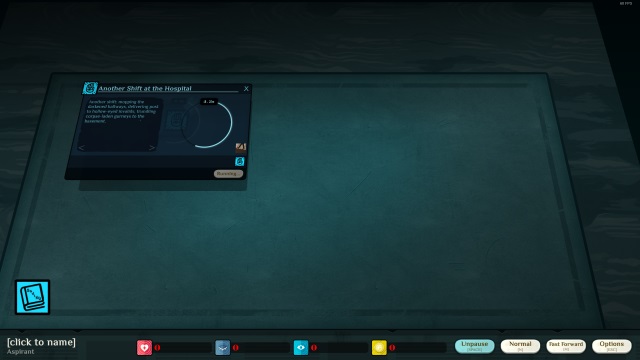
Because you have to discover what’s going on, it’s important to pause the game whenever something happens. While paused, you need to click on every new icon and card you acquire and read the pop-up attached to it.
The pop-ups come with a small narrative description to add richness to the ever-changing world of Cultist Simulator. These descriptions may plainly detail what these cards do or only hint at the answer, forcing you to guess and hope for the best.
At the bottom-right of each card and icon, you will see an array of ‘Aspect’ symbols. These detail what the icon wants or what the card does. For example, an icon may have a small, purple potion symbol called ‘ingredient’ in it. This means the icon requires an ingredient in order for something to happen; this ingredient may be forcefully taken from you or willingly given to produce a particular outcome.
During your game, you may want to feed a particular card to an icon, such as ‘Work’, to develop it further. The game does not point this out to you or send you a notification that this is happening. It simply happens. If you miss it, you suffer the consequences.While not placing a card in the icon may benefit you, ignoring it likely harms you, and you’ll have to swiftly recover from the consequences. This is the developers at Weather Factory prompting you to not remain idle — keep on your toes as much as possible, and read all of the Aspect symbols!
Resource Management
The first part of the game has you struggling to maintain the four main resources: Health, Passion, Reason, and Funds. Of the four, I’ve lost multiple times due to not having enough Health, or I’ve sometimes found myself struggling to acquire funds.
The game does not tell you how to obtain more. With some experimentation (and some quick deaths), I was able to discover how to do this.
I found out that when you place your resource cards in select icons, you can acquire new cards that remain on the board for a limited time. You use these limited-time cards to develop and grow your standard resources — a welcome discovery that, even early on, gives you a sense of accomplishment and progress.
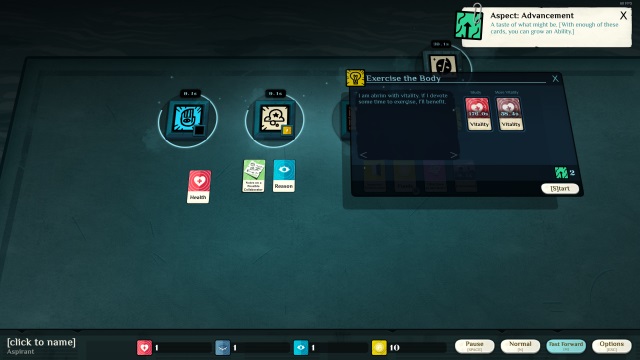
For example, one of the earliest things you learn is that you need to maintain a decent pool of Health. You can acquire more through using your Health resource cards on the ‘Study’ icon, gaining Vitality.
Vitality only lasts on the board for three minutes and then disappears. If you acquire two Vitality at the same time, you can place them back into the ‘Study’ icon and earn a new Health card, adding it to your total resource pool.
All of this takes time. And during this time, the board is steadily working against you, not waiting for you to feel ready or prepared.
You have to pay the ‘Time Passes’ icon a Fund card every minute to survive. This means you have to earn money faster than you’re using it, and you may want a few Fund cards in your back pocket to purchase a piece of Occult Lore.
The game’s random-number generator always feels set against you, too.
You may feel like every time you’re about to use a Reason card to further develop your resource pool, the game demands you use your last one for your job or suffer the consequences.
Are the consequences worth it? Do you reserve that card to receive that instant gratification of a bigger resource pool, or do you stave off your angry boss?
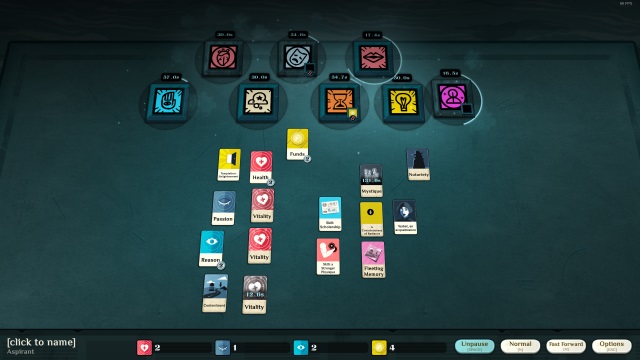
You will constantly ask yourself these questions, wondering when you’re going to get a break — which you never do. This game does not hold your hand, and you should never expect it to. You must pay attention and learn from your past mistakes in order to succeed.
Steep Learning Curve
I finally discovered on my third or fourth game of Cultist Simulator how to earn more resource cards. When I learned this new skill, a new door in the game seemed to open up; I was rewarded for my efforts by being allowed to look deeper.
Each time I sat down to play a new deck, I had more tools I could use to help me survive longer. The game keeps these mechanics in plain sight and rewards you if you’re willing to work to understand. Cultist Simulator feels like a massive web where when you pull on one thread, eight more strands become available for you to pull.
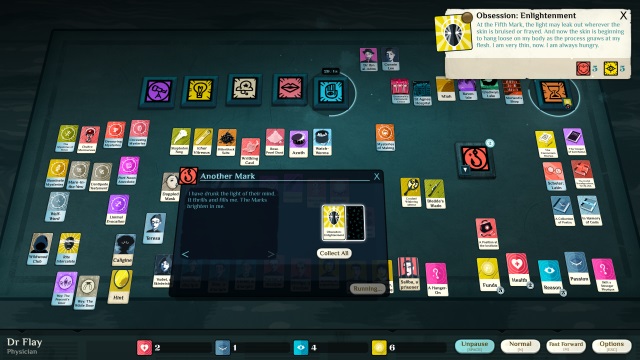
However, this may push a good portion of the player base away from this game. These difficult mechanics take a good deal of time to learn, and if you’re not careful, you’ll find yourself dead and back at the start with little to show for it.
This is what Weather Factory expects to happen. The developers want you to try again. This way, the small victories you have, like discovering how to add more cards to your resource pool, feel meaningful.
Did you die from having too many Dread cards on the board? If these pop up enough times, you can spend a good portion of a new game learning how to earn a Contentment card, which counters Dread.
Did a noisy inspector learn too much about your cult and build a case against you? Spend time learning more about your followers and how to upgrade them. After a bit of digging, you can learn how to turn them into deadly assets any sane enemy would rightfully fear, and that inspector is no longer a problem.
Leading Your Cult
Once you’re past the initial start of the game, you’ll begin leading your cult. This means you start shepherding your cult’s followers, keeping your notoriety in check, and discovering new Lore cards to use for your many arcane devices.
As you steadily continue your nefarious activities to advance your cult’s goals, reporters and detectives may start to grow curious about your actions. Thankfully, you are not alone.
Your followers come into play during the mid-to-late game. Their devotion to you remains absolute, and their skills are at your command. Should you feel a reporter asks too many questions, poisoning their tea or driving them mad can stifle any future problem. The same goes for completing a dangerous cult ritual — who better to sacrifice than a willing follower whose only purpose is to expand your rightful doctrine?
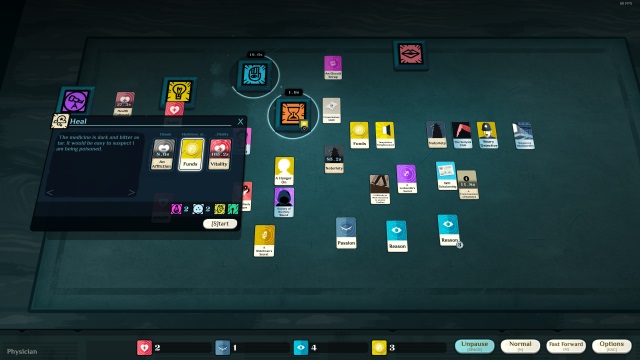
Every play you make comes with two sides: a consequence and a reward. These consequences sting your hand and fill you with regret, but the rewards keep you going and drive you to see the light at the end of the tunnel — even if the light is your death.
You adapt, you evolve. Because experience is the only thing you take with you between your games, you cling to it and establish it as your creed. As you learn more, you discover new possibilities available to you and untangle the massive web hidden behind Cultist Simulator to find the thread of victory.
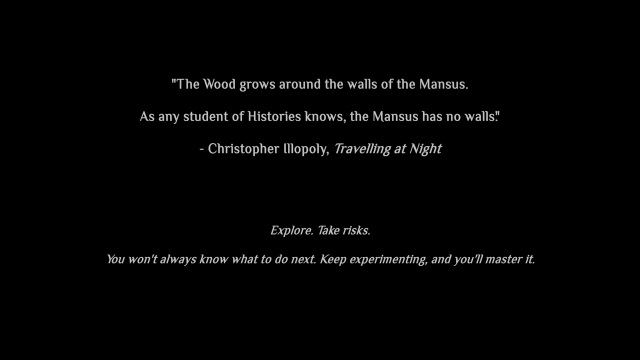
At the End of the Day
Starting out in the game can feel like a chore. You stumble, fail, and continually feel like the game unfairly killed you for something you barely understood.
Once you get past the first few games and start learning how everything clicks together, you get sucked in. There’s plenty going on in Cultist Simulator, and the game rewards you for every new detail you uncover and use.
Those with the willpower and skill set to find the right card combinations for a victory will reap the rewards.
Note: A review copy was provided by the publisher.

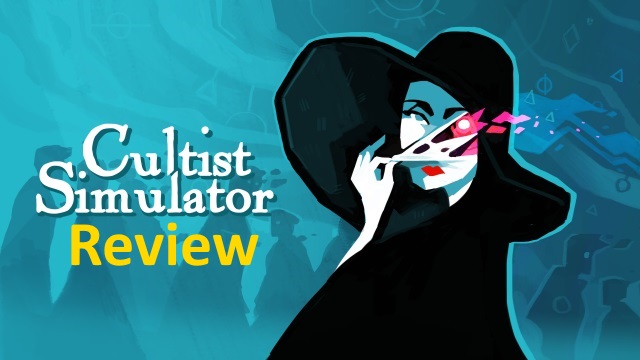





Published: Jun 5, 2018 03:24 pm